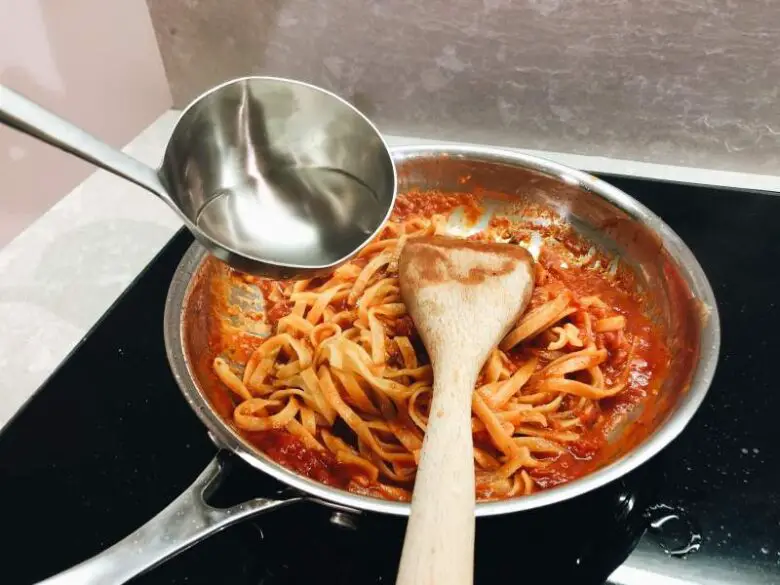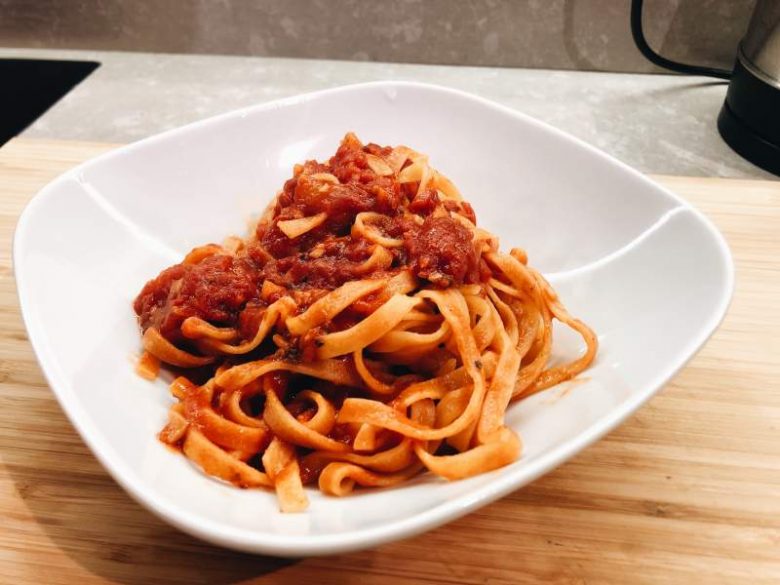A reader reached out to me yesterday, asking if I could help troubleshoot her pasta cooking technique. “I did everything the recipe said,” she wrote, “yet I couldn’t get the sauce to cling to the noodles. What am I doing wrong?”
The question was so good, I thought of dedicating an entire post on the topic. If you, like Jane from Ohio, came here wondering how to get pasta noodles to stick to the sauce, that’s exactly what I’m going to help you find out.
To get sauce to cling to your pasta, boil the noodles 2-3 minutes less than the cooking time on the package. Transfer them to your saucepan and finish cooking them with the sauce over medium-high heat for about 60-90 seconds. Use high-quality, bronze-die noodles and don’t add olive oil to the pot.
In the rest of this post, I’m going to break down the reasons why this technique is so effective—and show you how to best apply it.
By the time you’re done reading, you’ll know how to cook the most perfect pasta dishes every single time you fire up the stove.
Bold promise, I know. Keep me accountable in the comments if I don’t deliver.
Use Bronze-Die Pasta Noodles
When it comes to getting the sauce to cling to pasta, the quality of the noodles matters more than most of us think.
The boxed pasta that you and I buy in the grocery store is made on a commercial scale in pasta factories. Some brands make pasta only in Italy, others (typically the biggest pasta producers) in facilities all over the world.
Commercial pasta is made on a production line that uses machines to mix flour and water into a dough. In a process called “extrusion,” the fresh pasta dough is then pushed through molds called “dies” that cut it into shapes and forms.
Pasta dies are made of durable metal and covered with food-grade coating that comes in direct contact with the dough. In general, pasta manufacturers use two types of coatings for their pasta dies: ones coated with non-stick and ones coated with bronze.
Non-stick dies are more modern. They’re also cheaper to buy and use, which is why they’re used by most pasta manufacturers today. Bronze dies are older and more traditional. As with most traditional methods in food production, they’re also more expensive to own and operate.
Sauce clings better to noodles extruded through bronze dies (also called “bronze-die” or “bronze-cut” pasta) because they have a rougher, more porous surface compared to their non-stick-cut counterparts.
A package of bronze-die pasta costs a few dollars more than non-stick-die pasta—and it’s worth every single extra penny. The moment you taste it, you’ll notice an instant difference in the way that the sauce clings on to the pasta and hides in the small nooks and crannies of every noodle.
Wonder who sells bronze-die pasta?
Check out our list of the best Italian pasta brands in the grocery store.
Sauce the Pasta the Right Way
I used to work for a Fortune 500 company with a large office that had a Sodexo cafeteria downstairs. For my years of service, I only tried the pasta once—and regretted it many times after.
That day, the kitchen staff had cooked the noodles hours in advance, coated them generously with oil to prevent them from sticking, and put them in one of those stainless steel food pans right next to the sauce.
My turn came and I ordered the pasta. So the lady behind the counter grabbed a white plate, put a forkful or two of noodles on it, poured a ladle of tomato sauce on top, and, in an unsuccessful attempt to fake a smile, handed it over to me, shouting “Next!”
Many of us make the same mistake when saucing pasta at home. We plate the noodles, pour the sauce on top, and serve them on the table (hey, at least we shout “Dinner’s ready!” and not “Next!”).
You can taste the difference just by looking at it.
Check out the two photos below. On the left is a plate of fusilli that haven’t been tossed with the sauce at all. On the right, the same pasta variety has been cooked with the tomatoes in the saucepan.

But there’s a better way to sauce pasta. In fact, it’s so good that your pasta will come out tasting like the best Italian food you’ve ever had—every single time you fire up the stove.
Here’s how it works:
Boil the pasta for 2-3 minutes less than the time on the package to almost al dente. Then transfer it to your saucepan with ½ soup ladle of pasta water, and finish cooking it with the sauce over medium-high heat for about 60-90 seconds.
This cooking technique works just as well with tomato-, cream-, and cheese-based sauces. And it makes your pasta more appetizing in two ways.
First, the noodles will soak up the aroma and flavor of the sauce as you finish them off in the pan. Second, the starchy and salty pasta water will thicken and season the sauce as it simmers down over medium-high heat. As a result, your pasta dish will come out consistent and savory.
Stir the pasta and toss it in the pan as you do this. The movement will help to incorporate the ingredients together.



Don’t Add Olive Oil to the Pasta Water
When it comes to cooking pasta, two of the most common mistakes that home cooks like you and me tend to make are in the way that we use olive oil. Mistake no. one is adding olive oil to the pasta water.
Contrary to popular belief, adding olive oil to the pasta water won’t keep the noodles from sticking together. The scientific explanation for why this is a myth is that oil and water molecules simply don’t mix.
When you do this, most of the olive oil will end up floating on the surface of the pasta water—and you’ll discard it as soon as you pour it down the drain. Small portions of the oil will coat some of the noodles with a greasy layer that will keep the sauce from clinging to them after saucing.
When I learned this a few years back, I stopped adding olive oil to pasta water. Extra virgin olive oil, the kind that I use in most of my home cooking, doesn’t come cheap. And I’m pretty sure that I can find better uses for it than pouring it down the drain.
Never add olive oil to your pasta pot; it has no place there. Olive oil should only be used for sautéeing minced garlic or making a sofrito for the sauce. Some Italians also like to drizzle it on plated pasta (that’s already been sauced).
Don’t Toss Leftover Pasta Noodles in Olive Oil
Here’s the second mistake that many of us make when cooking pasta at home.
You boiled more pasta than you and your household can eat in a single meal—and you’re not keen on throwing good food away. You could leave them in the water, but that would turn them soggy beyond repair. You could transfer them to a food storage container, but they’d stick.
So you toss the leftover pasta noodles in a hefty amount of olive oil to keep them from sticking (since there’s no more water involved, this time this trick works), place them in a bag or container, and store them in the fridge for later in the week.
The problem with this technique is that, when you reheat the pasta and try to sauce it, the olive oil will have coated the noodles so well, it will be impossible for any of the sauce to cling to them. Leftover pasta is already unappetizing. Leftover bland pasta is simply too much.
The fix?
Even if you boiled more pasta than you can eat, toss all of the noodles with the sauce, saving them for later. Whenever you feel like eating the leftovers, reheat them over medium heat in a saucepan over with the help of ½ soup ladle of water, stirring gently.
The water will bring back moisture to the sauce, which will then declump the pasta. Just be sure to not add too much water to it or you’ll need to let it simmer for 2-3 minutes to reduce the moisture (potentially overcooking the pasta).
In Conclusion
Getting sauce to cling to the pasta noodles is ultimately about three things: (1) cooking with high-quality noodles, (2) tossing the pasta with the sauce using the correct technique, and (3) avoiding the most common mistakes that keep the noodles from sticking to the sauce in the first place.
If you tried the tips and tricks in this post and want to share your experience with applying them, leave a comment below.
If you’re wondering what to read next, check out my thoughts on the science of cooking pasta. In a shopping mood? My list of the 10 must-have tools for making pasta will help you pick the crème de la crème for gearing-up your home kitchen.

